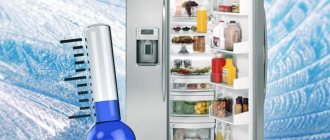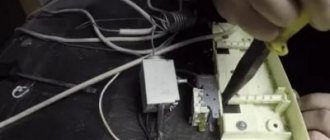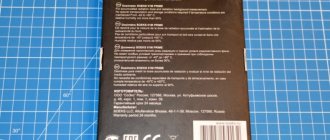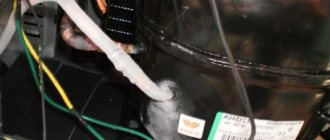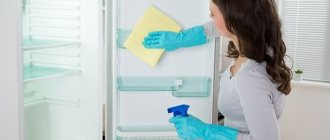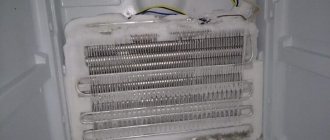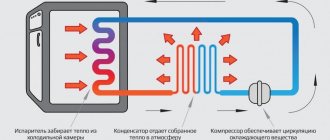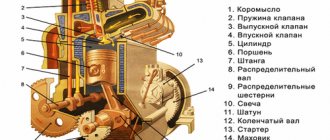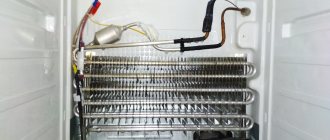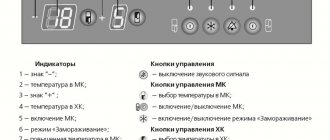Freon is an inert gas, odorless. At atmospheric pressure it boils at a temperature below zero. But the compressor creates such pressure that the refrigerant condenses into liquid, heating the circuits, before turning back into gas in the evaporator. The cooling process of the chambers requires a certain amount of refrigerant. Leakage reduces the cold performance of the device. The technician’s task is to find where freon has leaked from the refrigerator, eliminate the fistula and pump in a new portion of refrigerant.
Signs of a freon leak in the refrigerator
An insufficient amount of freon disrupts the thermal balance and uses less heat for evaporation. The cause of a refrigerant leak from a refrigerator is almost always due to a violation of the operating instructions:
- Improper transportation of the refrigerator, loading and installation with sudden jerks can lead to the destruction of welding seams.
- Speeding up defrosting by mechanically removing the ice using a knife or fork can damage the tubes in the freezer.
- Rare defrosting, accumulation of ice, and melting near the door contribute to rusting of the tubes in the heating circuit. Fistulas form at the bottom where moisture seeps through the seal.
- Natural aging of the material, corrosion.
- Manufacturing defects.
If there is not enough freon in the refrigerator, the compressor will work without stopping, and the chamber will be warm. A specialist with the necessary equipment can accurately determine both leaks and other faults. Similar signs may occur when the door is not tightly closed or the integrity of the gaskets is compromised.
To independently determine whether there is freon in the refrigerator, you should defrost and dry the device. If, after turning it on, the cold does not build up in the chambers, the condenser grille is cold, the freon has leaked out. What to do? Need refueling.
conclusions
A freon leak can only temporarily disrupt the correct operation of the refrigerator and lead to increased electricity consumption due to the fact that the compressor will work constantly.
This gas does not pose any other dangers. However, it is not recommended to repair the refrigerator yourself, change filters, solder and refill freon if you do not have the necessary skills to do so.
By negligence, you can cause yourself a rather unpleasant injury, and calling a specialist will cost a fairly modest amount. In addition, many repairmen provide a warranty period after their repairs, which is also a significant advantage.
Subscribe to our Social networks
What does freon look like leaking from a refrigerator?
How to detect a leak yourself? In open areas, the puncture site will be indicated by a black spot - the gas has escaped, and the oil in the circuit is non-volatile, it remains around the fistula. If a tube rupture occurs in the foamed part of the refrigerator, the chamber wall will swell, indicating the location of the leak. A specialist in finding freon leaks in a refrigerator uses a leak detector - a device that works on the principle of a metal detector. Having detected the location of damage, the device beeps.
You can determine that freon has leaked from the refrigerator if the chambers are warm and there is a brown oily puddle on the floor near the compressor. The refrigerant evaporated at room temperature, leaving oil, decomposition products, and condensation as a trace. You can understand that freon has leaked from the refrigerator yourself as soon as puddles of melted food and the uniform noise of a running compressor are detected. If you touch the capacitor - the grille on the end part - it will be cold. This is the surest indicator that the freon in the refrigerator has run out.
Definition
Freon is a substance consisting of methane and ethane in a certain proportion. It is inert to the environment. The refrigerant can be in liquid or gas form. As it evaporates, it absorbs heat while releasing cold. There are about 40 types of refrigerant. The refrigerator uses some types of freon that are safe for humans and the environment.
Attention! It should be remembered that freon is not only found in refrigerators. It is used for refilling air conditioners and other cooling equipment, fire extinguishing agents, and for medical and cosmetic aerosols and sprays. Freon is part of polyurethane foam and some types of paints and varnishes.
The substance is odorless and transparent, so it is not possible to detect a leak by color and aroma in the air. You can find out about a malfunction of the cooling system only by subjective factors: the presence of condensation on the walls of the chamber, poor freezing or its absence. The following types of freon are used for household appliances:
- R600a (isobutane) is a substance of natural origin that does not destroy ozone in the atmosphere, but it can explode in concentrations above 31 g/m3; a small amount of gas is used in the refrigerator, which cannot lead to an explosion;
- R134a (tetrafluoroethane) is a safe gas that does not contain chlorine, the refrigerant is colorless and odorless, inert to the environment, does not ignite at plus or minus temperatures, and has a zero degree of ozone layer destruction;
- R12 (difluorodichloromethane) - prohibited for use in modern household appliances since 2010, has a sweetish odor like ether, does not burn in domestic conditions, explodes at temperatures above 330 ° C, and at a concentration above 30% leads to suffocation;
- R22 (difluorochloromethane) - found in old-style refrigerators, has a clearly noticeable smell of chloroform, destroys the ozone layer, but its destructive ability is lower than that of its analogue R12; when exposed to an open flame and heated to 250 ° C, it decomposes into highly toxic substances.
You can determine the type of freon in the refrigerator using the information indicated on the label for the compressor. The type of substance is also specified in the technical documentation for the unit. Modern models of freezers and refrigerators charge only R600a and R134a, which are not dangerous if leaked.
How to check for freon leaks in a refrigerator
When users complain about the unpleasant smell from the refrigerator and associate it with a freon leak, they are right. Yes, the gas is colorless and odorless. But the refrigerant gradually evaporates into the microscopic hole. The climate in the cell changes. Microparticles of pathogens appear, creating an unpleasant odor. This is due to high humidity. What to do if you suspect that freon is coming out of the refrigerator?
- Check how often the compressor stops or whether it runs continuously.
- Check the integrity of the door seal and the tightness of the circuit connection. Take a sheet of thick, high-quality paper, cut a strip of 5 cm and stretch it through the closed door. It drags with difficulty - the seal is normal.
- The compressor does not stop, there is no cold, check the voltage in the network. The compressor performance is 0 if the network is 185 V. The motor will work, but there will be no compression.
If other causes are excluded, contact a specialized center for diagnosis. A specialist knows how to determine the presence or absence of freon in a refrigerator.
What to do if freon leaks from your refrigerator and why is it dangerous?
Situations with freon leakage are not so rare among residents of our country. But those who are most responsible for their health ask themselves the question of how harmful the gas is to the human body when it leaks?
The answer to this question is a reassuring answer: in 99.9% of cases, the gas used cannot harm a person. It is non-toxic under normal living conditions, absolutely fireproof and cannot cause an explosion due to its concentration even in a small kitchen.
Did you know?! Varieties of cooling gas freon R134a, R12, R22 and R600a are used in all modern refrigerators. Under normal conditions (temperatures up to 250 degrees Celsius) and a concentration in a standard kitchen of up to 400 grams, it is absolutely safe for the human body and the risk of fire or explosion, since the maximum concentration in the refrigerator is only 200 grams.
Therefore, in cases where a gas leak occurs, you should not take any immediate measures to seal the system, because most likely a significant amount of gas has already leaked out. You just need to find a quality technician who can quickly, safely, and most importantly inexpensively fix your problem.
Internal freon leak in refrigerator
The most expensive repair if freon has leaked from the refrigerator is considered to be changing the refrigerant circuit. The price of the work depends on the location of the leak. If it is a door heating circuit, it is turned off and the tube is laid along the rear wall. If a fistula has formed in the body, it is necessary to remove the insulation, re-lay the circuit and foam it.
The work is expensive, but even in a workshop it is impossible to recreate the factory circuit. Repairs that damage the thermal insulation change the thermodynamic properties of the chambers. Some companies, for example, Liebherr, consider refrigerators with a freon leak in the foam part beyond repair. Within 10 years of operation, they, according to the conclusion of their own service center, can change the device, contrary to Russian trade rules.
Fixing a freon leak in a refrigerator
Various methods of restoring tightness are used in the circuit. An aluminum evaporator uses solder to an aluminum base to repair punctures.
The junction of a copper tube with an aluminum one is performed by argon welding on a special installation. It is possible that gas escapes at the junction of the fitting and the compressor, and the rest of the circuit does not require repair. The technician has several ways to determine the location of the freon leak in the refrigerator. The repairman's actions occur in the following sequence:
- fault diagnosis;
- detection of cracks and fistulas in the cooling circuit tubes, troubleshooting at home or in the workshop;
- vacuuming the system to remove condensate and freon residues;
- filling the circuit with gas in a certain volume;
- checking the system for tightness and cooling ability.
If, after pumping in the refrigerant, the cooling effect has decreased and the suction tube into the compressor is frozen - a lot of freon has been pumped in - recharging is required at the expense of the technician.
How to detect a freon leak
Determining a gas leak from a household cooling device is quite simple. You just need to periodically show a little more attention to its operation, the signals it gives and the sounds it makes.
Many modern refrigerators are equipped with special sensors that allow the owner to understand that a malfunction has occurred and to eliminate it as quickly as possible. Therefore, owners of new refrigerator models can only check the presence of such a function and periodically monitor the appearance of leaks using sound or visual alerts.
Most often, owners notice a gas leak, referring to the incorrect operation of the compressor. It works constantly, or in other words, “wear and tear”, and the required cooling effect is insufficient or not at all.
Perhaps the owner decided to independently remove the ice on the walls of the freezer with a sharp or cutting object, and inadvertently stuck it into the wall. A characteristic whistle or hiss is a clear sign of a freon leak.
A visual inspection of the refrigerator can help locate leaks. If there are traces of rust along the contour of the freezer door, then most likely the leak is occurring along the cooling perimeter of the door.
A visual inspection allows you to detect the presence of leaks at the soldering points of the aluminum alloy and copper tube and evaporator. In these places there is usually the formation of ice, which is difficult not to notice even with the naked eye.
This is due to the fact that manufacturers can produce products of insufficient quality, and then make money by selling spare parts. Although such malfunctions are more common in budget versions of refrigerators, even the highest-quality manufacturers cannot guarantee an uninterrupted service life of equipment for several decades.
This is due to the principle of operation of the refrigerator, namely the constant presence of slight vibration, due to which microcracks in the copper tubes can gradually increase until small streams of cooling gas escape from them.
If the leak cannot be visually found, the pipe system can be lubricated with a soap solution. This method helps to find even small leaks, because bubbles will form at the leakage site. But the most accurate methods for finding leaks are modern methods that use the latest equipment: halogen, electronic and ultrasonic leak detectors. Their use is most often necessary to search for leaks that are inaccessible for visual inspection.
Freon leak in the refrigerator - is it worth repairing?
Compared to replacing the compressor, finding a crack and restoring the circuit is much cheaper. The refrigerator gets a second life. There are cases when an evaporator, repaired 15 years ago, still works in an old refrigerator in exile in the country. Freon cannot just leak out of the refrigerator. The cold circuit is sealed. Over the years, a leak may develop at the junction between the copper and aluminum tubing. In Russian models, leaks are often found in the door heating circuit. Inexpensive repairs return the device to full functionality. That’s why, as soon as you find out that freon has leaked from the refrigerator, you need to call a technician as soon as possible. This operation cannot be performed independently - the risk of adding several more to one problem is too great.
How to find a freon leak in a refrigerator yourself
If the compressor doesn't stop running, remember how it all started. Perhaps there was meat in the freezer, and you tore it off the wall with ice. Or maybe, in an effort to defrost the chamber faster, they “gently” pushed the ice crust away from the surface with a knife. At that moment, a slight hiss was heard, and soon everything became quiet. Was? Then the cause of the leak is obvious. The problem itself will not be solved; soon all the gas will be released, and the food will begin to spoil. It is necessary to call a technician to repair the damage or replace the evaporator.
